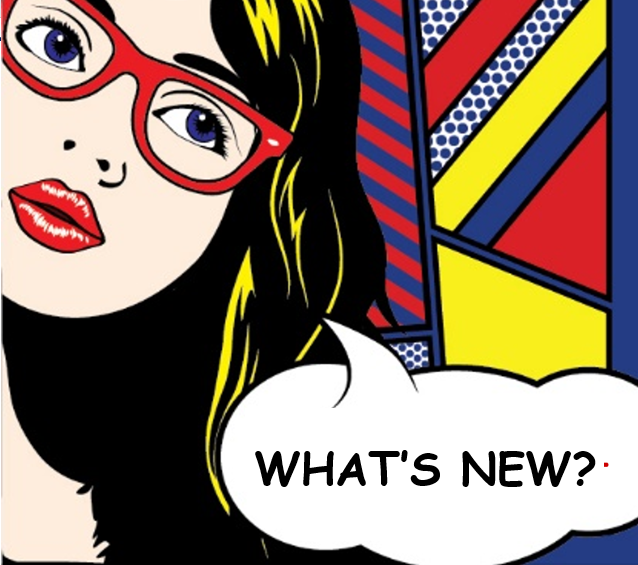
Most of you know I’m a big believer in audience research – I have been throughout my entire 50+ year career. My very first job in the business was working for an audience research firm where I cut my teeth on writing, analyzing, and producing research studies for the biggest companies in radio. It was a big stage for someone in their early twenties trying to figure out how it all worked.
No, research can’t answer all our questions – especially when we try to test a concept, a format, or a personality respondents have never heard before. But when it comes to gaining an understanding of a known product, concept, or piece of content, a well-crafted research study fielded to a properly screened sample can be invaluable.
All that said, complex questions requiring a degree of nuance can be especially challenging to research. And that leads me to the premise of today’s post.
So full disclosure: I have absolutely no research to back up the assertion I’m about to make, but my gut reaction is there’s something’s going on that I think is of importance. I conduct more focus groups and one-on-one interviews than anyone in radio, and have done so for decades. There’s something very raw and visceral about sitting in a room with a group of radio listeners, whether in person or on a platform like Zoom.
Not only do you directly hear how people express themselves when talking about – with conviction or shakily – you can see their facial expressions and even their body language. After awhile, whether you’re moderating groups in Washington, Wichita, or Waterloo, you pick up on patterns in the way and even the speed with which people respond to questions.
 And my strong suspicion is that audience perceptions of radio have slipped and continue to weaken. Because we’re always talking to those still listening to the radio, I can’t even account for those who are no longer using the medium. But among consumers still tuned into commercial, public, and Christian radio here in the U.S., my belief is their attention has lessened, driven largely by the glut of entertainment and information available on so many platforms.
And my strong suspicion is that audience perceptions of radio have slipped and continue to weaken. Because we’re always talking to those still listening to the radio, I can’t even account for those who are no longer using the medium. But among consumers still tuned into commercial, public, and Christian radio here in the U.S., my belief is their attention has lessened, driven largely by the glut of entertainment and information available on so many platforms.
When radio was one of just a handful of media options – TV, print, etc. – the act of listening was more focused and streamlined. Before smartphones, there were simply fewer distractions and less multi-tasking. Yet, even back in the day, few were giving radio their undivided attention. Radio – and audio in general – is conducive to doing something else while you’re taking in the content. It’s just now that radio is one of infinite choices people have. The fact that even so-called P1s may not be up-to-speed with what their favorite station is doing shouldn’t surprise us.
Take the Nielsen proposal radio broadcasters are not considering that would lower the bar on quarter-hour crediting in PPM from the current five minute rule in any 15 minute period down to just three. What does that tell us about the lessening level of engagement people have with radio? What does it tell us about how much less they’re really listening? It all comes back to radio’s current struggle to gain and hold attention, to stand out, and to remain relevant.
I would suggest to you that in a world where marketing dollars are at a premium – or even nonexistent – radio needs to be more intentional and more strategic about the way it markets itself using its own resources. (Note that I didn’t limit that last point to radio’s own air – these days, every radio station has access to myriad communication and marketing platforms.)
its own resources. (Note that I didn’t limit that last point to radio’s own air – these days, every radio station has access to myriad communication and marketing platforms.)
But how well do most stations actually use the resources currently available? Do most stations treat their promotional avails with the same care and treatment they would with a TV, outdoor, or social media campaign? How surgical are radio stations and their programmers about using their marketing resources strategically? And how much creativity and attention-getting techniques are being utilized in the crafting of self-promotional campaigns?
A lot of questions, and of course, your mileage may vary. That is, every station is going to answer them differently depending on the situation, brand strength, competitive environment, as well as other key variables.
But I know this – when a station uses mostly its own air to promote something of value, a few “mentions” or even recorded slots a day isn’t likely to get the message across anymore. When their placement and exact frequency are left to chance, the odds of these facts becoming widely known by the core audience lessen considerably.
I would submit the situation may be more dire in public and Christian radio where their respective missions often overshadow a radio station’s format building blocks and basic messaging. Public radio stations, in particular, have notoriously gone under-promoted because content managers consciously shy away from production or any missive that sounds gratuitous. The lack of hype may be beneficial to shaping the overall contours of a station’s sound. But much of the important detail about a station, including scheduling basics, often fly well below the average listener’s radar.
This hit me earlier this week while doing my routine sweeps of tech websites, such as Mashable, Ars Technica, and TechCrunch. I was surfing around the latter for news and announcements when it hit me that tech and media sites are highly publicizing and promoting small improvements, features, new releases and updates, partnerships, collaborations, and even the minutia of doing business. Whether it’s Apple, Tesla, TikTok, Amazon or the hundreds of other players in the space, they all realize their news is only important when it is heard. It’s the old “tree falling in the forest” analogy, now set in our modern world.
The other day I ran across this page on the TechCrunch website:
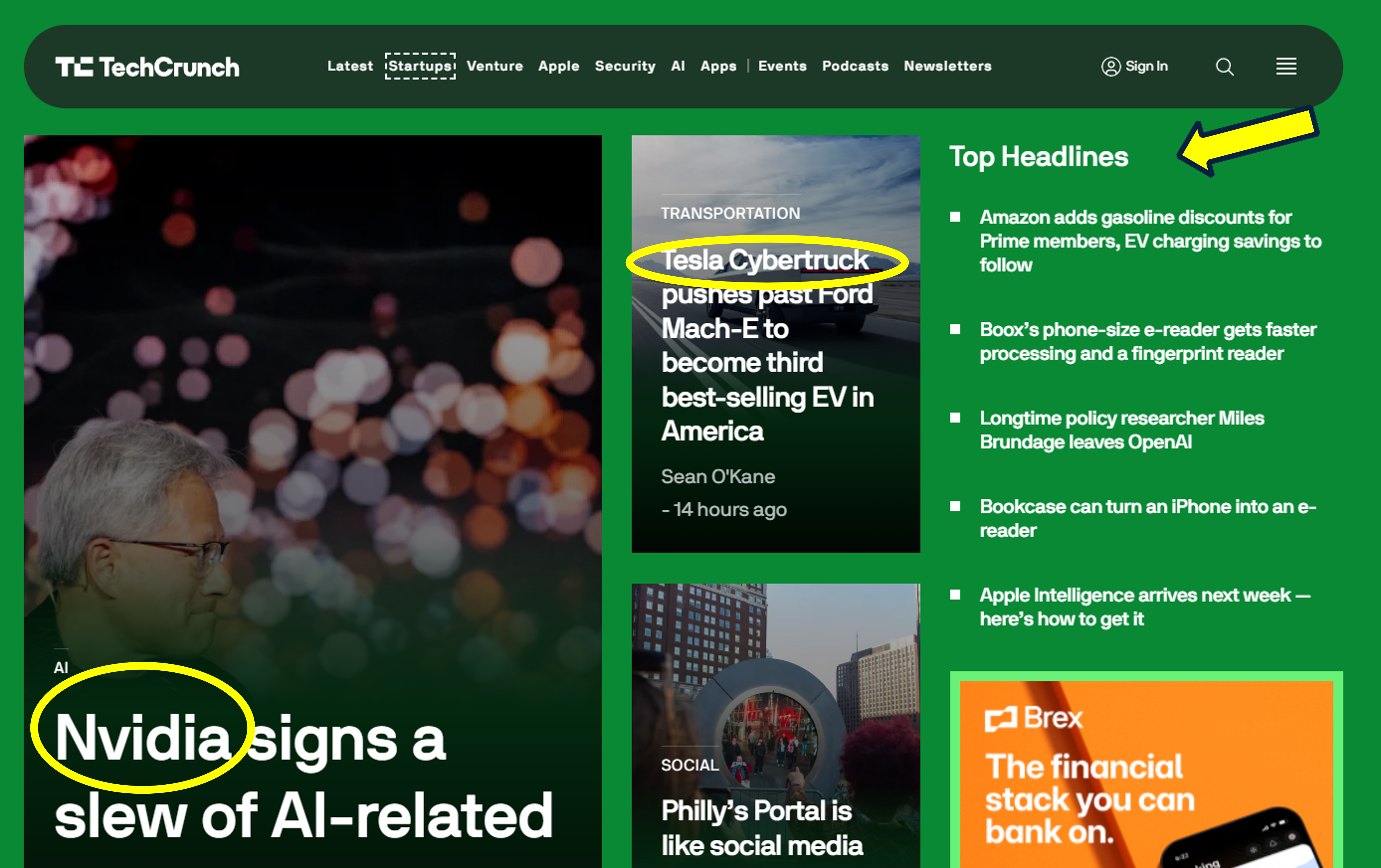
The stories about two of the hottest companies – Nvidia and Tesla – earn the biggest piece of web real estate. Meanwhile, under “Top Headlines,” we’ve got another day of news impacting the community. Every nuance and detail gets amplified – a new app, a new product, faster processing speeds – when a company makes a story a big deal, consumers are more likely to “tune in.” And if you’re already a user or a gadget owner – or you’re thinking about becoming one – these promotional announcements become even more meaningful to you.
Most tech and big media companies never miss the moment, the opportunity to tell friends, followers, customers, and users about what they’re up to. And particularly if you’re a fan of a brand, a product, a service, or a celebrity, you have a desire to know more. And don’t snark me with the response there’s nothing on the radio worth promoting. That’s simply not true.
But when radio downplays or outright ignores many of its promotable assets, why would the average listener care?
Think about the near-total absence of syndicated programming on stations over the weekend. The conventional wisdom is these shows have too much talk, making them PPM unfriendly. While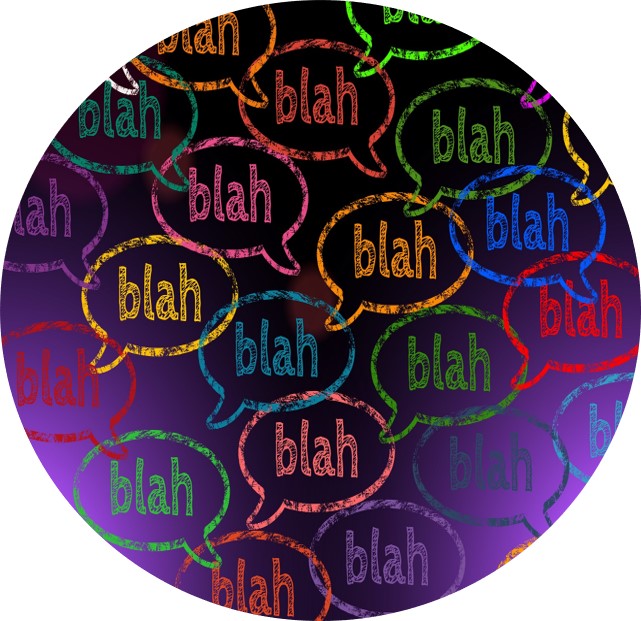 there may be some truth to that, another variable that’s contributed to their low profile and acceptance is just how under-promoted these shows were on the stations that carried them. If a station doesn’t make a big deal out of its programming, its features, its special weekends, and even its giveaways, how can we expect the audience to have a whole lot of interest in them?
there may be some truth to that, another variable that’s contributed to their low profile and acceptance is just how under-promoted these shows were on the stations that carried them. If a station doesn’t make a big deal out of its programming, its features, its special weekends, and even its giveaways, how can we expect the audience to have a whole lot of interest in them?
And these days in our fragmented world where we can experience any content, any time, and on any device, how much more promotional firepower does it now require for the average listener to even be aware of what you’re doing, much less become interested enough to actually listen to it?
Most PDs are promotionally treating their stations like it’s 1999 – not like the tsunami of news, information, technology that we’re living in the middle of. One of the fascinating aspects of going to CES isn’t just the gadgets and the apps – it’s how brands are unveiling their products, and marketing and promoting them. CES has thousands of companies displaying their latest and greatest, and each one of them is trying to cut through the clutter to gain attention.
That’s where FOMO comes from – the insatiable need to know what’s going on now – not tomorrow or even later today. NOW.
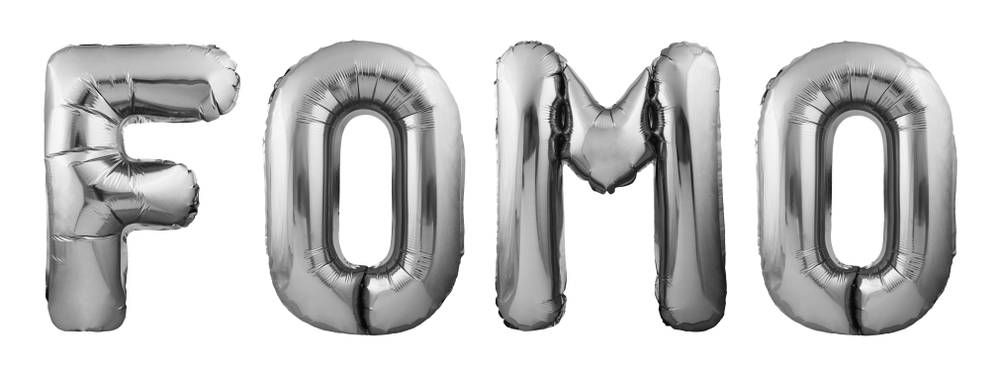
If your radio station isn’t generating much in the way of news about what it’s doing, audience interest comes to a halt. Without buzz and anticipation, even a core listener isn’t looking forward to anything new. Every day sounds the same. The station’s flow slows to a trickle.
Rethinking the promotional architecture and overall approach promotionally is something we’re researching and studying more and more these days. Even something as simple as using the station website and app for basic notification is table stakes, but often not executed well.
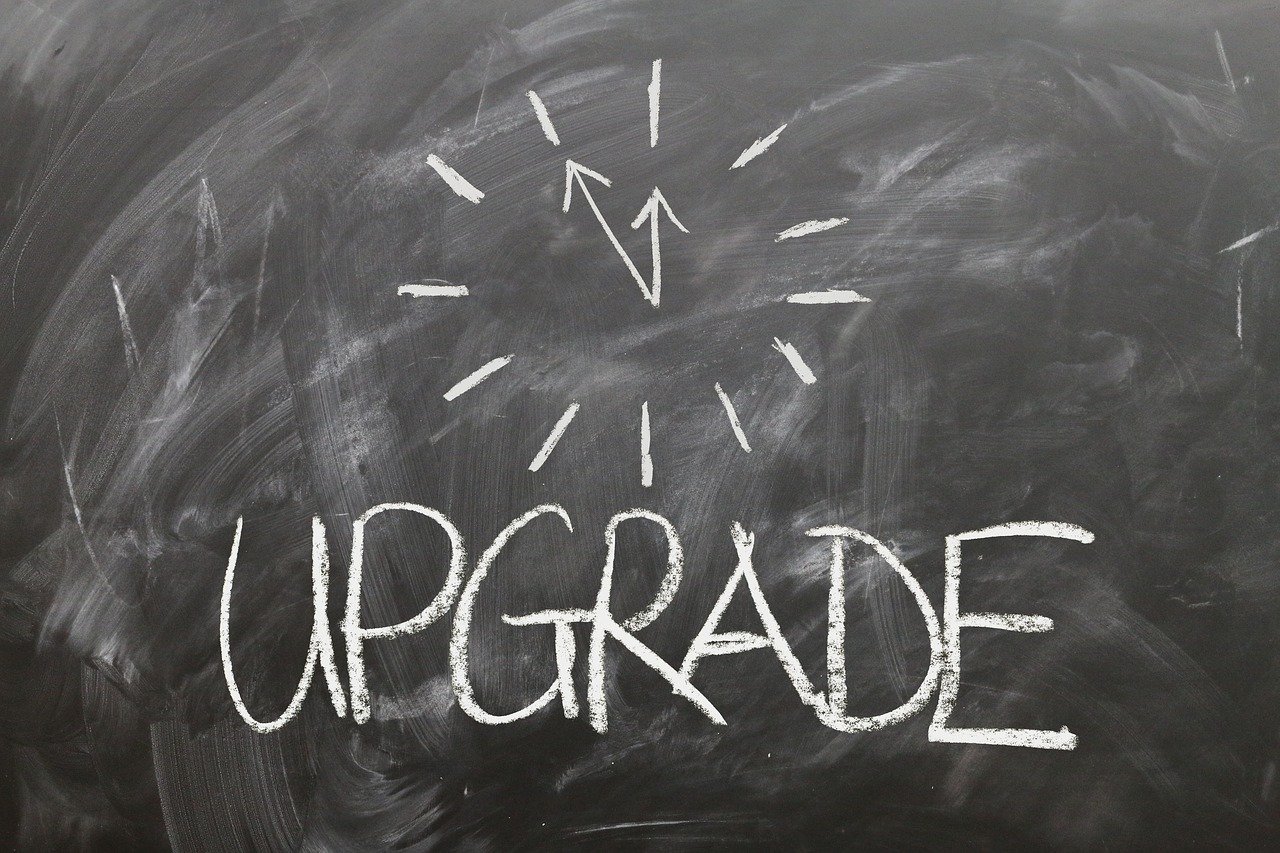 And it should go beyond a major giveaway or client promotion. Say you make a change to your clocks and add another ’80s song an hour because you did research or your gut tells you it’s something you should do. Rather than hope the audience organically hears the change, why not let them know? For a radio station, it’s the equivalent of when Apple updates the OS on its iPhones. When you change the clocks or the music categories or you add another giveaway time, it’s no different than a “system update.” In fact, you could position it as an “upgrade,” just like tech companies do. Why not draw attention to the change rather than hope they’ll figure it out. The faster the audience is up to speed on your changes, the quicker you’ll know whether it’s working.
And it should go beyond a major giveaway or client promotion. Say you make a change to your clocks and add another ’80s song an hour because you did research or your gut tells you it’s something you should do. Rather than hope the audience organically hears the change, why not let them know? For a radio station, it’s the equivalent of when Apple updates the OS on its iPhones. When you change the clocks or the music categories or you add another giveaway time, it’s no different than a “system update.” In fact, you could position it as an “upgrade,” just like tech companies do. Why not draw attention to the change rather than hope they’ll figure it out. The faster the audience is up to speed on your changes, the quicker you’ll know whether it’s working.
Another underused FOMO generator is a station’s email database, your secret weapon to seamlessly inform thousands of your best listeners about “what’s goin’ on?” on your station? A basic communiqué laying out “the new new thing” at your station is probably the shortest distance between two rating books to get your message delivered.
Or start a newsletter for database members that comes out bimonthly where you can lay out what you’re doing and why it’s essential for fans to know. (And if you don’t have enough “breaking news” items to fill up a color one-page newsletter every two weeks, than maybe your problem actually starts with content generation, and not strategy. But there are likely more things going on at the station than you might even realize, more than enough to populate a basic laundry list of what you’re up to.
fans to know. (And if you don’t have enough “breaking news” items to fill up a color one-page newsletter every two weeks, than maybe your problem actually starts with content generation, and not strategy. But there are likely more things going on at the station than you might even realize, more than enough to populate a basic laundry list of what you’re up to.
You might also find it’s a great tool for the entire staff, many of whom may not be listening to the station to begin with. You can’t mandate they tune in the station, but you can make sure no one has an excuse for not knowing about what the station is doing this week.
If it’s more important, time-sensitive, and even immediate, there’s push messaging on your mobile app and dashboard metadata to consider. Both can be timely and impactful and should be used judiciously and carefully. But they should be used when you’re going for a reaction right here and now.
And don’t forget those QR codes we’ve been telling you about the past few years. These days, they’re a free, ubiquitous, and effective way to drive audience and connect them with resources that matter to them. Our Techsurveys (see below) tell us that across radio platforms, more than seven in ten core listeners use QR codes – and it’s growing every year.

Bottom line? You’re got to generate FOMO, that sense your station isn’t a mechanical, one-dimensional utility, but a living, breathing brand that is present and constantly informing, entertaining, or both. And making sure you’ve got an on and off-air promotional and marketing scheme capable of delivering your messaging.
It doesn’t matter your format, your platform, or your market. Or your budget. Lower operating expenses and fewer staffers might impact the P&Ls this quarter, but they won’t change how audiences perceive and engage with your brand right now today, and in the long haul. But if you don’t tell them, how will they know?
It starts with answering the age-old question:
“What’s goin’ on?”
- For Radio, Where Does Digital Revenue Go From Here? - June 6, 2025
- “My Favorite Decade Of Music Is The __’s” - June 5, 2025
- Who’s Got It Better? Talent In Commercial Radio vs. Talent in Christian Music Radio - June 4, 2025




The most important elements that drove people to radio in the past were immediacy and localization. One or both are largely lost with syndicated programming and voice-tracking. Secondly, studies show that personalities delivering content are more effective than canned commercials. The same is true for delivering station promotion, yet I still hear canned liners far more often than live (or pseudo-live) humans delivering promos. And how many liners are poorly written in the first place?
Automated scheduling of commercials, poorly or incorrectly categorized commercials, lack of separation rules, and repeated commercials in a set are FOMO killers. Worse, they’re a tune-out. As bad as they are OTA, they’re significantly worse for online listeners, where different language and out-of-market commercials also run on too many stations.
Radio has the ability to fix its own problems, but it will require more humans to either program the automation better, or schedule more intelligently in the first place. Hubbing generally hasn’t worked out for the advertiser or the listener.